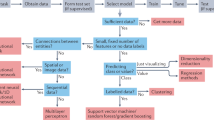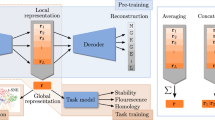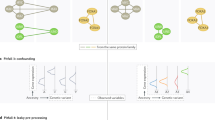Abstract
Recent advances in machine learning have enabled the development of next-generation predictive models for complex computational biology problems, thereby spurring the use of interpretable machine learning (IML) to unveil biological insights. However, guidelines for using IML in computational biology are generally underdeveloped. We provide an overview of IML methods and evaluation techniques and discuss common pitfalls encountered when applying IML methods to computational biology problems. We also highlight open questions, especially in the era of large language models, and call for collaboration between IML and computational biology researchers.
This is a preview of subscription content, access via your institution
Access options
Access Nature and 54 other Nature Portfolio journals
Get Nature+, our best-value online-access subscription
$32.99 / 30 days
cancel any time
Subscribe to this journal
Receive 12 print issues and online access
$259.00 per year
only $21.58 per issue
Buy this article
- Purchase on SpringerLink
- Instant access to full article PDF
Prices may be subject to local taxes which are calculated during checkout



Similar content being viewed by others
References
Miller, T. Explanation in artificial intelligence: insights from the social sciences. Artif. Intell. 267, 1–38 (2019).
Doshi-Velez, F. & Kim, B. Towards a rigorous science of interpretable machine learning. Preprint at https://arxiv.org/abs/1702.08608 (2017).
Azodi, C. B., Tang, J. & Shiu, S. -H. Opening the black box: interpretable machine learning for geneticists. Trends Genet. 36, 442–455 (2020).
Eraslan, G., Avsec, Ž., Gagneur, J. & Theis, F. J. Deep learning: new computational modelling techniques for genomics. Nat. Rev. Genet. 20, 389–403 (2019). This paper gives an extensive review of the application of deep learning models in genomics.
Talukder, A., Barham, C., Li, X. & Hu, H. Interpretation of deep learning in genomics and epigenomics. Brief. Bioinform. 22, bbaa177 (2021).
Novakovsky, G., Dexter, N., Libbrecht, M. W., Wasserman, W. W. & Mostafavi, S. Obtaining genetics insights from deep learning via explainable artificial intelligence. Nat. Rev. Genet. 24, 125–137 (2023). This paper provides a comprehensive review for the commonly applied IML methods in biology through the examples from regulatory genomics.
Klauschen, F. et al. Toward explainable artificial intelligence for precision pathology. Annu. Rev. Pathol. 19, 541–570 (2024).
Avsec, Ž. et al. Effective gene expression prediction from sequence by integrating long-range interactions. Nat. Methods 18, 1196–1203 (2021).
Avsec, Ž. et al. Base-resolution models of transcription-factor binding reveal soft motif syntax. Nat. Genet. 53, 354–366 (2021). This paper is a representative example of applying post hoc explanation methods and connecting the feature importance scores with biological interpretations.
Schwessinger, R. et al. DeepC: predicting 3D genome folding using megabase-scale transfer learning. Nat. Methods 17, 1118–1124 (2020).
Karimi, M., Wu, D., Wang, Z. & Shen, Y. DeepAffinity: interpretable deep learning of compound–protein affinity through unified recurrent and convolutional neural networks. Bioinformatics 35, 3329–3338 (2019).
Vig, J. et al. BERTology meets biology: interpreting attention in protein language models. In International Conference on Learning Representations (ICLR, 2021).
Taujale, R. et al. Mapping the glycosyltransferase fold landscape using interpretable deep learning. Nat. Commun. 12, 5656 (2021).
Ma, J. et al. Using deep learning to model the hierarchical structure and function of a cell. Nat. Methods 15, 290–298 (2018). This paper illustrates a biologically informed neural network that incorporates the hierarchical cell subsystems into the neural network architecture.
Tasaki, S., Gaiteri, C., Mostafavi, S. & Wang, Y. Deep learning decodes the principles of differential gene expression. Nat. Mach. Intell. 2, 376–386 (2020).
Tao, Y. et al. Interpretable deep learning for chromatin-informed inference of transcriptional programs driven by somatic alterations across cancers. Nucleic Acids Res. 50, 10869–10881 (2022).
Theodoris, C. V. et al. Transfer learning enables predictions in network biology. Nature 618, 616–624 (2023).
Barnett, A. J. et al. A case-based interpretable deep learning model for classification of mass lesions in digital mammography. Nat. Mach. Intell. 3, 1061–1070 (2021).
Zaritsky, A. et al. Interpretable deep learning uncovers cellular properties in label-free live cell images that are predictive of highly metastatic melanoma. Cell Syst. 12, 733–747 (2021).
DeGrave, A. J., Cai, Z. R., Janizek, J. D., Daneshjou, R. & Lee, S. -I. Auditing the inference processes of medical-image classifiers by leveraging generative AI and the expertise of physicians. Nat. Biomed. Eng. https://doi.org/10.1038/s41551-023-01160-9 (2023).
Heil, B. J. et al. Reproducibility standards for machine learning in the life sciences. Nat. Methods 18, 1132–1135 (2021).
Whalen, S., Schreiber, J., Noble, W. S. & Pollard, K. S. Navigating the pitfalls of applying machine learning in genomics. Nat. Rev. Genet. 23, 169–181 (2022).
Sapoval, N. et al. Current progress and open challenges for applying deep learning across the biosciences. Nat. Commun. 13, 1728 (2022).
Chen, V., Li, J., Kim, J. S., Plumb, G. & Talwalkar, A. Interpretable machine learning: moving from mythos to diagnostics. Commun. ACM 65, 43–50 (2022). This paper describes the disconnect between IML techniques and downstream use cases and outlines paths forward to bridge the disconnect.
Räuker, T., Ho, A., Casper, S. & Hadfield-Menell, D. Toward transparent AI: a survey on interpreting the inner structures of deep neural networks. In 2023 IEEE Conference on Secure and Trustworthy Machine Learning (SaTML), 464–483 (IEEE, 2023).
Yang, M. & Ma, J. Machine learning methods for exploring sequence determinants of 3D genome organization. J. Mol. Biol. 434, 167666 (2022).
Shrikumar, A., Greenside, P. & Kundaje, A. Learning important features through propagating activation differences. In International Conference on Machine Learning, 3145–3153 (PMLR, 2017).
Sundararajan, M., Taly, A. & Yan, Q. Axiomatic attribution for deep networks. In International Conference on Machine Learning, 3319–3328 (PMLR, 2017).
Selvaraju, R. R. et al. Grad-CAM: visual explanations from deep networks via gradient-based localization. In Proceedings of the IEEE International Conference on Computer Vision, 618–626 (2017).
Nair, S., Shrikumar, A., Schreiber, J. & Kundaje, A. fastISM: performant in silico saturation mutagenesis for convolutional neural networks. Bioinformatics 38, 2397–2403 (2022).
Lundberg, S. M. & Lee, S. -I. A unified approach to interpreting model predictions. In Proceedings of the 31st International Conference on Neural Information Processing Systems, 4768–4777 (2017).
Ribeiro, M. T., Singh, S. & Guestrin, C. “Why should I trust you?” explaining the predictions of any classifier. In Proceedings of the 22nd ACM SIGKDD, 1135–1144 (2016).
Tseng, A., Shrikumar, A. & Kundaje, A. Fourier-transform-based attribution priors improve the interpretability and stability of deep learning models for genomics. Adv. Neural Inf. Process. Syst. 33, 1913–1923 (2020).
Rudin, C. Stop explaining black box machine learning models for high stakes decisions and use interpretable models instead. Nat. Mach. Intell. 1, 206–215 (2019).
Hastie, T. & Tibshirani, R. Generalized additive models: some applications. J. Am. Stat. Assoc. 82, 371–386 (1987).
Elmarakeby, H. A. et al. Biologically informed deep neural network for prostate cancer discovery. Nature 598, 348–352 (2021).
Fortelny, N. & Bock, C. Knowledge-primed neural networks enable biologically interpretable deep learning on single-cell sequencing data. Genome Biol. 21, 190 (2020).
Janizek, J. D. et al. PAUSE: principled feature attribution for unsupervised gene expression analysis. Genome Biol. 24, 81 (2023). This paper proposes an approach to combining the post hoc and by-design explanation methods.
Vaswani, A. et al. Attention is all you need. In Advances in Neural Information Processing Systems, 5998–6008 (2017).
Karbalayghareh, A., Sahin, M. & Leslie, C. S. Chromatin interaction–aware gene regulatory modeling with graph attention networks. Genome Res. 32, 930–944 (2022).
Serrano, S. & Smith, N. A. Is attention interpretable? In Proceedings of the 57th Annual Meeting of the Association for Computational Linguistics, 2931–2951 (2019).
Jain, S. & Wallace, B. C. Attention is not explanation. In Proceedings of NAACL-HLT, 3543–3556 (2019).
Wiegreffe, S. & Pinter, Y. Attention is not not explanation. In Proceedings of EMNLP-IJCNLP, 11–20 (2019).
Bai, B. et al. Why attentions may not be interpretable? In Proceedings of the 27th ACM SIGKDD Conference on Knowledge Discovery & Data Mining, 25–34 (2021).
Conmy, A., Mavor-Parker, A. N., Lynch, A., Heimersheim, S. & Garriga-Alonso, A. Towards automated circuit discovery for mechanistic interpretability. In Thirty-seventh Conference on Neural Information Processing Systems, 16318–16352 (2023).
Friedman, D., Wettig, A. & Chen, D. Learning transformer programs. In Advances in Neural Information Processing Systems, vol. 36 (2023).
Alvarez Melis, D. & Jaakkola, T. Towards robust interpretability with self-explaining neural networks. In Advances in Neural Information Processing Systems, vol. 31 (2018).
Jacovi, A. & Goldberg, Y. Towards faithfully interpretable NLP systems: how should we define and evaluate faithfulness? In Proceedings of the 58th Annual Meeting of the Association for Computational Linguistics, 4198–4205 (ACL, 2020).
Yang, M. & Kim, B. Benchmarking attribution methods with relative feature importance. Preprint at https://arxiv.org/abs/1907.09701 (2019).
Adebayo, J., Muelly, M., Liccardi, I. & Kim, B. Debugging tests for model explanations. In Advances in Neural Information Processing Systems 33 (NIPS, 2020).
Kim, J. S., Plumb, G. & Talwalkar, A. Sanity simulations for saliency methods. In Proceedings of the 39th International Conference on Machine Learning, 11173–11200 (2022).
Zhou, Y., Booth, S., Ribeiro, M. T. & Shah, J. Do feature attribution methods correctly attribute features? In Proceedings of the AAAI Conference on Artificial Intelligence, 36, 9623–9633 (2022).
Agarwal, C. et al. Openxai: towards a transparent evaluation of model explanations. In Advances in Neural Information Processing Systems, 35 (2022).
Ghorbani, A., Abid, A. & Zou, J. Interpretation of neural networks is fragile. In Proceedings of the AAAI Conference on Artificial Intelligence, 33, 3681–3688 (2019).
Krishna, S. et al. The disagreement problem in explainable machine learning: a practitioner’s perspective. Preprint at https://arxiv.org/abs/2202.01602 (2022).
Zhao, Y., Shao, J. & Asmann, Y. W. Assessment and optimization of explainable machine learning models applied to transcriptomic data. Genomics Proteomics Bioinformatics 20, 899–911 (2022).
Tang, Z. et al. Interpretable classification of Alzheimer’s disease pathologies with a convolutional neural network pipeline. Nat. Commun. 10, 2173 (2019).
Zeiler, M. D. & Fergus, R. Visualizing and understanding convolutional networks. In (eds. Fleet, D et al.) Computer Vision – ECCV 2014. ECCV 2014. Lecture Notes in Computer Science, vol 8689. Springer, Cham. https://doi.org/10.1007/978-3-319-10590-1_53 (2014).
Shrikumar, A. et al. Technical note on transcription factor motif discovery from importance scores (TF-MoDISco) version 0.5. 6.5. Preprint at https://arxiv.org/abs/1811.00416 (2018).
Rahman, M. A. & Rangwala, H. IDMIL: an alignment-free interpretable Deep Multiple Instance Learning (MIL) for predicting disease from whole-metagenomic data. Bioinformatics 36, i39–i47 (2020).
Wang, L. et al. An interpretable deep-learning architecture of capsule networks for identifying cell-type gene expression programs from single-cell RNA-sequencing data. Nat. Mach. Intell. 2, 693–703 (2020).
Nagao, Y., Sakamoto, M., Chinen, T., Okada, Y. & Takao, D. Robust classification of cell cycle phase and biological feature extraction by image-based deep learning. Mol. Biol. Cell 31, 1346–1354 (2020).
Lafarge, M. W. et al. Capturing single-cell phenotypic variation via unsupervised representation learning. In International Conference on Medical Imaging with Deep Learning, 315–325 (PMLR, 2019).
Tan, J. et al. Cell-type-specific prediction of 3D chromatin organization enables high-throughput in silico genetic screening. Nat. Biotechnol. 41, 1140–1150 (2023).
Dalla-Torre, H. et al. The nucleotide transformer: building and evaluating robust foundation models for human genomics. Preprint at bioRxiv https://doi.org/10.1101/2023.01.11.523679 (2023).
Abnar, S. & Zuidema, W. Quantifying attention flow in transformers. In Proceedings of the 58th Annual Meeting of the Association for Computational Linguistics 4190–4197 (ACL, 2020).
Tang, X. et al. Explainable multi-task learning for multi-modality biological data analysis. Nat. Commun. 14, 2546 (2023).
Washburn, J. D. et al. Evolutionarily informed deep learning methods for predicting relative transcript abundance from DNA sequence. Proc. Natl Acad. Sci. USA 116, 5542–5549 (2019).
Nguyen, E. et al. HyenaDNA: Long-range genomic sequence modeling at single nucleotide resolution. In Advances in Neural Information Processing Systems, 36 (2024).
Zhou, Z., Ji, Y., Li, W., Dutta, P., Davuluri, R. V. & Liu, H. DNABERT-2: efficient foundation model and benchmark for multi-species genomes. In International Conference on Learning Representations (ICLR, 2024).
Wei, J. et al. Chain-of-thought prompting elicits reasoning in large language models. Adv. Neural Inf. Process. Syst. 35, 24824–24837 (2022).
Liu, K., Casper, S., Hadfield-Menell, D. & Andreas, J. Cognitive dissonance: why do language model outputs disagree with internal representations of truthfulness? In Proceedings of the 2023 Conference on Empirical Methods in Natural Language Processing 4791–4797 (2023).
Srivastava, D., Aydin, B., Mazzoni, E. O. & Mahony, S. An interpretable bimodal neural network characterizes the sequence and preexisting chromatin predictors of induced transcription factor binding. Genome Biol. 22, 20 (2021).
Chen, R. J. et al. Pathomic fusion: an integrated framework for fusing histopathology and genomic features for cancer diagnosis and prognosis. IEEE Trans. Med. Imaging 41, 757–770(2020).
Liu, C., Huang, H. & Yang, P. Multi-task learning from multimodal single-cell omics with Matilda. Nucleic Acids Res. 51, e45 (2023).
Liang, P. P. et al. MultiViz: towards visualizing and understanding multimodal models. In Eleventh International Conference on Learning Representations (2023).
Valeri, J. A. et al. BioAutoMATED: an end-to-end automated machine learning tool for explanation and design of biological sequences. Cell Syst. 14, 525–542 (2023).
Ji, Y., Zhou, Z., Liu, H. & Davuluri, R. V. DNABERT: pre-trained bidirectional encoder representations from transformers model for DNA-language in genome. Bioinformatics 37, 2112–2120 (2021).
Acknowledgements
This work was supported in part by the National Institutes of Health Common Fund 4D Nucleome Program grant UM1HG011593 (to J.M.), National Institutes of Health Common Fund Cellular Senescence Network Program grant UH3CA268202 (to J.M.), National Institutes of Health grants R01HG007352 (to J.M.), R01HG012303 (to J.M.) and U24HG012070 (to J.M.), and National Science Foundation grants IIS1705121 (to A.T.), IIS1838017 (to A.T.), IIS2046613 (to A.T.) and IIS2112471 (to A.T.). J.M. was additionally supported by a Guggenheim Fellowship from the John Simon Guggenheim Memorial Foundation, a Google Research Collabs Award and a Single-Cell Biology Data Insights award from the Chan Zuckerberg Initiative. A.T. was additionally supported by funding from Meta, Morgan Stanley and Amazon. Any opinions, findings and conclusions or recommendations expressed in this material are those of the author(s) and do not necessarily reflect the views of any of these funding agencies.
Author information
Authors and Affiliations
Contributions
Conceptualization, V.C., M.Y., A.T. and J.M.; investigation, V.C., M.Y., W.C., J.S.K., A.T. and J.M.; writing, V.C., M.Y., A.T. and J.M.; funding acquisition, A.T. and J.M.
Corresponding authors
Ethics declarations
Competing interests
A.T. received gift research grants from Meta, Morgan Stanley, and Amazon. J.M. received gift research grant from Google Research. A.T. works part-time for Amplify Partners. The other authors declare no competing interests.
Peer review
Peer review information
Nature Methods thanks Maxwell Libbrecht and Juan Caicedo for their contribution to the peer review of this work. Primary Handling Editor: Lin Tang, in collaboration with the Nature Methods team.
Additional information
Publisher’s note Springer Nature remains neutral with regard to jurisdictional claims in published maps and institutional affiliations.
Rights and permissions
Springer Nature or its licensor (e.g. a society or other partner) holds exclusive rights to this article under a publishing agreement with the author(s) or other rightsholder(s); author self-archiving of the accepted manuscript version of this article is solely governed by the terms of such publishing agreement and applicable law.
About this article
Cite this article
Chen, V., Yang, M., Cui, W. et al. Applying interpretable machine learning in computational biology—pitfalls, recommendations and opportunities for new developments. Nat Methods 21, 1454–1461 (2024). https://doi.org/10.1038/s41592-024-02359-7
Received:
Accepted:
Published:
Issue date:
DOI: https://doi.org/10.1038/s41592-024-02359-7
This article is cited by
-
A mechanism-informed deep neural network enables prioritization of regulators that drive cell state transitions
Nature Communications (2025)
-
Empowering scientific discovery with explainable small domain-specific and large language models
Artificial Intelligence Review (2025)
-
Letter to the Editor: Navigating bias in machine learning—reevaluating feature importances through robust statistical analysis
European Radiology (2025)
-
Embedding AI in biology
Nature Methods (2024)



